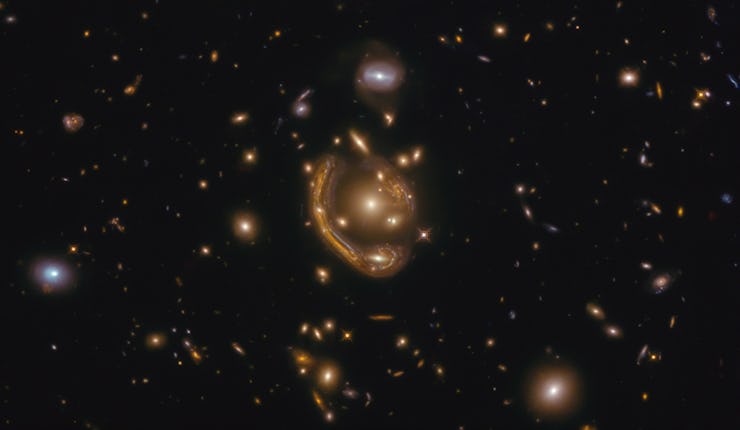Astronomers Use Optical Illusion to Unveil a Gargantuan Black Hole
30 billion times the mass of the Sun.

Astronomers just found another case of something out there bigger than a supermassive black hole: ultramassive black holes, which are the true behemoths of the Universe, clocking in at over 10 billion times the mass of our Sun.
While there aren’t any fundamental differences between supermassive and ultramassive black holes besides their size, scientists sometimes use the term to set apart the really big ones. The ultramassive black holess we know of are few and far between, but a recent discovery could add another to the mix.
Two billion light years away in the galaxy cluster Abell 1201, scientists detected a dormant black hole that’s 30 billion times the Sun’s mass. Thanks to gravitational lensing, a phenomenon first predicted by Albert Einstein, they were able to shed a light on the previously undetected giant.
A gravitational lens from a bright background object can be seen here surrounding the galaxy cluster CL0024+1654.
The astronomers behind the newly discovered black hole described their findings Wednesday in the journal Monthly Notices of the Royal Astronomical Society.
Gravitational lensing happens when bright light from a background object, such as a galaxy cluster or quasar, becomes bent around a foreground object. It creates an optical illusion from our vantage point on Earth, making it seem like streaks of light are forming a patchy circle around the object closer to our planet.
Not only was the black hole a big finding, but gravitational lensing helped the researchers create a new technique for discovering other dormant black holes. Such objects don’t emit large amounts of energy or interact with their surroundings, making them trickier to find.
In the case of Abell 1201, gravitational lensing created a duplicate image of the cluster’s brightest galaxy that helped scientists take a closer look at the black hole at its center. Previous research showed that a black hole was present, but it wasn’t clear until now how big the object was.
Looking at the lensed images of Abell 1201, researchers trained a computer program to test out possible sizes for the known black hole. Simulations revealed that a black hole with 30 billion solar masses seemed the most likely.
This video sums up how the gravitational lensing technique works:
“Gravitational lensing makes it possible to study inactive black holes, something not currently possible in distant galaxies,” said Durham University cosmologist James Nightingale in a press release. “This approach could let us detect many more black holes beyond our local universe and reveal how these exotic objects evolved further back in cosmic time.”
Gravitational lensing has also helped researchers in recent years identify distant galaxies and exoplanets. And with its potential for uncovering some of the sneakiest black holes out there, we could be on the cusp of learning how some of these elusive objects came to be.